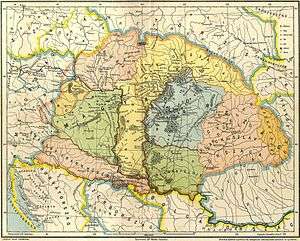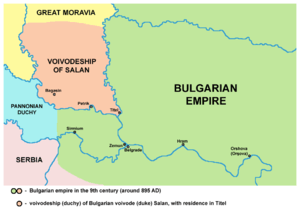Salan


Salan, Dux Salanus or Zalan (Bulgarian and Serbian Cyrillic: Салан or Залан; Hungarian: Zalán; Romanian: Salanus) was, according to the Gesta Hungarorum, a local Bulgarian[1] voivod (duke) who ruled in the 9th century between Danube and Tisa rivers in the south and Carpathians in the north. The capital of his voivodship (duchy) was Titel. The exact border of his duchy is not clear: according to some sources, his duchy included present-day northern Serbia, much of present-day central Hungary, present-day eastern Slovakia and part of present-day western Ukraine and northern Romania,[1] while according to other sources his duchy included only present-day Bačka region of Serbia and Hungary.[2]
History
According to Gesta Hungarorum, Salan (Salanus) was an Orthodox vassal of the Byzantine Empire or of the Bulgarian tsar (Emperor), but it is not clear if he was of Bulgarian origin or from the local Slavic, Vlach or Avar population. Serbian historian Dr Aleksa Ivić supposes that Salan was a Slavic king.[3] The chronicle states that he was descendant of the Bulgarian Khan who conquered the territory up to the borders of Russia and Poland after the death of Attila the Hun.
At the time of Hungarian conquest (after 896), Hungarians attacked Salan's voivodship and Bulgarians led by the tsar Simeon came to the aid of voivod Salan and even the Byzantine Emperor sent auxiliary troops against the Hungarians. The Hungarians defeated a united Bulgarian and Byzantine army led by Salan in the early 10th century on the plains of Alpar [4] and the voivodship of Salan fell under Hungarian rule.
Name origin
There is a theory that his name means "the salt man", so it could be a name given to him by the authors of the chronicles, describing the role he had: supplying salt for his suzerain (supposedly the tsar Simeon the Great of Bulgaria). By some opinions name Salanus has a Latin resonance and, by this view, it might have Latin or Vlach origin.
Sources
The main historical source about duke Salan is a historical chronicle known as Gesta Hungarorum, written by Magister P., notary of Hungarian King Bela in the late 12th century. Gesta Hungarorum, however, is not considered to be a fully reliable source, thus the existence of Salan is questionable. However, the 10th century Lombard chronicler, Liudprand, also wrote about a Hungarian victory over the Bulgarians and the Byzantines in the early 10th century [5] and other sources also mention that area between Danube and Tisa was under Bulgarian rule, which confirm some claims from Gesta Hungarorum regarding the story about Salan. Nestor's chronicle also mentions that area between Danube, Tisa and Galicia was inhabited by Slavs and Vlachs, which also confirms some claims from Gesta Hungarorum regarding the entering of Magyar tribes in the Danube plain and battles against Slavs and Vlachs.[6]
See also
References
- 1 2 http://keptar.niif.hu/000500/000586/magyaro-honf-terkep_nagykep.jpg
- ↑ http://curug.rastko.net/9-vek/img/karta/9vek.jpg
- ↑ Dr Aleksa Ivić, Istorija Srba u Vojvodini, Novi Sad, 1929.
- ↑ "The Magyars - DBA 107". Fanaticus.org. 2002-03-10. Retrieved 2013-10-15. "Alpar" may be modern Tiszaalpár; recorded in 1075 as "Olper", when it was within the domains of Géza I.
- ↑ "The abstract of the book". Web.archive.org. 2009-10-27. Archived from the original on 2009-10-27. Retrieved 2013-10-15.
- ↑ G. Popa Lisseanu, Cronica Nestoris, Bucuresti, 1935, p.47.
Literature
- Marko Jovanov, Devet vekova od pomena imena Titela, Titelski letopis, Titel, 2001.
- Dr Aleksa Ivić, Istorija Srba u Vojvodini, Novi Sad, 1929.
- Prof.dr Radmilo Petrović, Vojvodina, Beograd, 2003.
- http://ro.scribd.com/doc/105973262/Izvoarele-istoriei-romanilor-Volumul-7-Cronica-lui-Nestor
External links
- Duchy of Salan (map)
- Duchy of Salan (map)
- Duchy of Salan (map)
- The Romanians in the work of anonymous notary
- The Magyars (650-997 AD)
- The "Gesta Hungarorum" and the Romanian continuity theory
- Gesta Hungarorum

